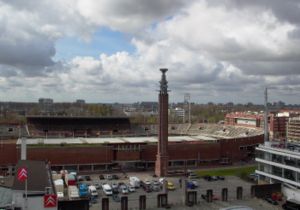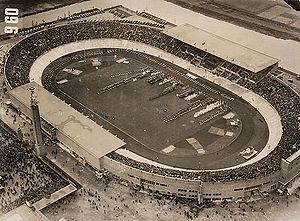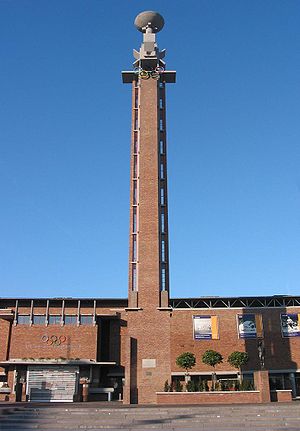- Olympic Stadium (Amsterdam)
-
Olympisch Stadion Location Amsterdam, Netherlands Broke ground 18 May 1927 Opened 28 July 1928 Renovated 1996–2000 Owner Gemeente Amsterdam Surface Grass Architect Jan Wils Capacity 22,288[1] Tenants AFC Ajax (until 1996, not for all matches)
Amsterdam Admirals (1995-1996)
Phanos (athletics) (Dutch)The Olympisch Stadion is a stadium built as the main stadium for the 1928 Summer Olympics in Amsterdam. When completed, the stadium had a capacity of 31,600. Following the completion of the rival De Kuip stadium in Rotterdam in 1937, the Amsterdam authorities decided to increase the capacity of the Olympisch Stadion to 64,000 by adding a second ring to the stadium. AFC Ajax used the Olympisch Stadion for international games until 1996, when the Amsterdam ArenA was completed.
Since 2005, the stadium is home to a sports museum, the Olympic Experience Amsterdam. It is no longer used as a football stadium.
Contents
Architecture and design
The Olympisch Stadion was designed by architect Jan Wils, and is one of the finest examples of Amsterdamse School architecture, complementing the surrounding neighbourhood designed by H.P. Berlage. The design won the Olympic gold medal in the architecture competition at the 1928 Olympics. The concrete second ring that was added in 1937 to the north and south wing of the stadium was also designed by Jan Wils.
Development history
The original plan of Jan Wils consisted of an extension of the Harry Elte stadium that was situated next to the current Olympisch Stadion. This plan was rejected as the municipal government of Amsterdam had planned an important urban development programme in that area, and wanted to demolish the stadium as soon as possible. The second plan was almost fully executed, and consisted of a new Olympisch Stadion that was situated more westward. In January 1926, the Amsterdam municipal government, the National Olympic Committee and the NV Nederlandsch Sportpark—the owner of the Harry Elte stadium—reached an agreement; after the Olympic Games of 1928, the Harry Elte stadium would be demolished and the NV Nederlandsch Sportpark would be the owner of the Olympisch Stadion. Starting in January 1926, the area in which the stadium was to be built was elevated by means of 750,000 cubic metres of sand. This phase was completed in October of that year and in the same month the construction of the pile foundation began. On 18 May 1927, the ceremonial first stone was placed by Prince Hendrik. Some two million stones would follow.[2]
Characteristics
The football pitch measures 114 by 75 metres. The athletics track around it is 8 metres wide and has a perimeter of 400 metres. The cycle track around the athletics track was 9 metres wide had a perimeter of 500 metres.[2] It also hosted the equestrian jumping, field hockey, and gymnastics events.
The capacity of the stadium is subject to controversy as the exact capacity was kept secret to press and public during the Games to evade the remark that the stadium's capacity was only marginally bigger than the Harry Elte stadium. It is said that two configurations could be set up in the stadium; one with 21,537 seats and 12,618 standing rooms (33,255 total) and one with 16,197 seats and 25,236 standing rooms (41,433 total).[2][3] After the Games the NOC admitted that the capacity of the stadium was somewhere near 31,600. Additional seats could be added on the cycle track, which would increase the capacity with 5,900.[2]
The 1928 Olympics introduced the idea of the Olympic Flame. The flame burned for the first time ever in a tall tower, known as the Marathon tower, adjacent to the Olympisch Stadion. In the top of the Marathon tower, four balconies are situated which were used during the Games by horn blowers. Above these balconies four speakers from Philips were attached, from which results and messages were broadcasted unto the Olympic area, a novelty at the time. The bowl on top which carried the Olympic flame was known to Amsterdammers as "the ashtray of KLM pilots".[2] A permanent Olymic flame burning during the tournament was also an Olympic first.
Renovation after being saved from demolition
In 1987 the city government announced plans to demolish the stadium. The stadium was saved, however, when it was listed as a national monument. Renovation started in 1996, and the stadium was refurbished into the original construction of 1928. The second ring of 1937 was removed, and the stadium was made suitable for track and field competitions again. The original bicycle track was also removed to enable the use of the space beneath the seats for offices. The stadium was reopened by the Prince of Orange on 13 May 2000.[4]
In 2007, the area around the stadium was renovated as part of larger urban renewal project covering the entire Olympic area. North of the stadium 969 houses were completed in 2008. In the same year, the islands in the river Schinkel to the west of the stadium were suited with tennis fields and football pitches, an athletics track and a park. The Stadionplein square in front of the stadium is also to be renovated, which is expected to begin in 2010.[5]
Two new bridges were also built around the stadium: to the south there is a new bridge suitable for all traffic, the Na Druk Gelukbrug, and to the Schinkel islands in the west there is a cyclists and pedestrian bridge, called Jan Wilsbrug.
Use after the Olympic Games
The stadium hosted several international matches of the Dutch national football team, the first one being the game against Uruguay (0–2) during the Summer Olympics on 30 May 1928. The last one was a friendly on 6 September 1989 against Denmark (0–2).
After the Olympics, the stadium was used regularly for various sporting events, including athletics, speedway, field hockey and cycling. The 1954 Tour de France, for example, started outside the stadium. However, it was football that remained the most popular. It was both the home ground of Blauw Wit FC and BVC Amsterdam (later merged into FC Amsterdam), while AFC Ajax used the stadium for games in which the crowd was expected to exceed the capacity of its own De Meer Stadion, or for midweek games which required the use of floodlights, with which the De Meer was not initially suited. Ajax continued this arrangement until the completion of the Amsterdam ArenA in 1996.
The stadium will host the 2016 European Championships in Athletics. [6] Because of this, an athletics track was added to the plan for the nearby Park Schinkeleilanden at the last moment. The athletics track in that nearby park, which could be a warming up track when using the main track in the Olympic Stadium for racing, was opened in 2008.[7] The stadium also serves as the start and finish of the Amsterdam Marathon, held every October.[8]
The stadium is also a tourist attraction. Tourists especially come from the Netherlands, Germany, Greece, Belgium, and Canada, and tours are available in Dutch, German, Greek, English and French.
In 1990 the Pixies recorded a video for their song Allison on the field.
Famous games
Famous games, apart from the Olympic Games, include:
- 1962 European Cup final between Benfica and Real Madrid, ending in a 5–3 Benfica victory
- Ajax's 5–1 victory over Liverpool on 7 December 1966
References
- ^ Vervolgstudie tijdelijke uitbreiding Olympisch Stadion Amsterdam
- ^ a b c d e Olf Kiers (1978) Jan Wils, Olympisch Stadion. Amsterdam: Van Gennep, Stichting Architectuur Museum. ISBN 90-6012-399-9
- ^ Paul Arnoldussen mentions in his Amsterdam 1928: het verhaal van de IXe Olympiade (ISBN 9060054687) a capacity of 21,809 seats and 13,216 standing rooms (35,025 total)
- ^ Johanneke Helmers (2006-12-07). "Het Olympisch Stadion" (in Dutch). Amsterdam.nl. Archived from the original on December 26, 2007. http://web.archive.org/web/20071226020819/http://amsterdam.nl/stad_in_beeld/inhoud/typisch_amsterdams?ActItmIdt=3833. Retrieved 2007-10-29.
- ^ "Het Olympisch Gebied" (in Dutch). Oudzuid.amsterdam.nl. Archived from the original on 2007-11-05. http://web.archive.org/web/20071105041415/http://www.oudzuid.amsterdam.nl/bouwen_en/olympisch_gebied. Retrieved 2007-10-29.
- ^ http://www.dutchnews.nl/news/archives/2011/11/amsterdam_to_host_2016_europea.php
- ^ Amsterdam.nl – Amsterdam kiest voor internationale atletiek[dead link]
- ^ "Course". ING Amsterdam Marathon. http://www.ingamsterdammarathon.nl/home/index.php?a=YTo3OntpOjU7YToxOntzOjQ6InBhZ2UiO3M6NDoiMTkxMCI7fXM6MjoiNWIiO2E6MTp7czo0OiJwYWdlIjtzOjQ6IjE5MTAiO31zOjI6IjVjIjthOjE6e3M6NDoicGFnZSI7czo0OiIxOTEwIjt9czoyOiI2YiI7YToxOntzOjQ6InBhZ2UiO3M6NDoiMjA4NyI7fXM6MjoiNmMiO2E6MTp7czo0OiJwYWdlIjtzOjQ6IjIwODciO31zOjI6IjZlIjthOjE6e3M6NDoicGFnZSI7czo0OiIyMDg3Ijt9aTo2O2E6Mjp7czo3OiJzdWJtZW51IjtzOjQ6IjIwODciO3M6NDoicGFnZSI7czo0OiIyMDg3Ijt9fQ==. Retrieved 2008-10-17.
- 1928 Summer Olympics official report. pp. 173–205.
External links
Preceded by
Wankdorf StadiumEuropean Cup
Final Venue
1962Succeeded by
Wembley StadiumPreceded by
Heysel StadiumEuropean Cup Winners' Cup
Final Venue
1977Succeeded by
Parc des PrincesFootball venues in the Netherlands Eredivisie Eerste Divisie Adelaarshorst · Berg & Bos · De Braak · Cambuur Stadion · Trendwork Arena · De Geusselt · GN Bouw Stadion · Heesen Yachts Stadion · Het Kasteel · Kras Stadion · Koning Willem II Stadion · Langeleegte · Jan Louwers Stadion · Mitsubishi Forklift Stadion · Schoonenberg Stadion · Univé Stadion · De Vliert · FC Zwolle StadionDefunct stadiums Alkmaarderhout · De Baandert · Diekman · Gemeentelijk Sportpark · Haarlem Stadion · Kaalheide · De Luiten · MariFlex Stadion · De Meer · Monnikenhuize · NAC Stadion · Nieuw Monnikenhuize · Sportpark Olympia · Olympisch Stadion · Oosterenkstadion · Oosterpark Stadion · Sportpark Noord · Wageningse Berg · Zuiderpark StadionSummer Olympic stadia Athens 1896 • Paris 1900 • St Louis 1904 • London 1908 • Stockholm 1912 • Antwerp 1920 • Paris 1924 • Amsterdam 1928 • Los Angeles 1932 • Berlin 1936 • London 1948 • Helsinki 1952 • Melbourne 1956 • Rome 1960 • Tokyo 1964 • México City 1968 • Munich 1972 • Montréal 1976 • Moscow 1980 • Los Angeles 1984 • Seoul 1988 • Barcelona 1992 • Atlanta 1996 • Sydney 2000 • Athens 2004 • Beijing 2008 • London 2012 • Rio de Janeiro 2016Venues of the 1928 Summer Olympics Amersfoort · Amsterdam · Buiten Y · Hilversum · Krachtsportgebouw · Monnikenhuize · Old Stadion · Olympic Sports Park Swim Stadium · Olympic Stadium · Schemzaal · Sloten · Sparta Stadion Het Kasteel · Zeeburg Shooting Grounds · ZuiderzeeList of Olympic venues in cycling 1896: Marathon (city), Neo Phaliron Velodrome • 1900: Vélodrome de Vincennes • 1904: Francis Field • 1908: White City Stadium • 1912: Liljeholmen, Mälaren • 1920: Antwerp, Vélodrome d'Anvers Zuremborg • 1924: Stade de Colombes, Vélodrome de Vincennes • 1928: Amsterdam, Olympic Stadium • 1932: Los Angeles Avenue, Pacific Coast Highway, Rose Bowl in Pasadena, Vineyard Avenue • 1936: Avus Motor Road, BSV 92 Field & Stadium • 1948: Herne Hill Velodrome, Windsor Great Park • 1952: Käpylä, Maunula, Pakila, Velodrome • 1956: Broadmeadows, Velodrome • 1960: Olympic Velodrome, Via Cassia, Via Flaminia, Via Cristoforo Colombo, Via di Grottarossa • 1964: Hachioji City, Hachioji Velodrome • 1968: Agustín Melgar Olympic Velodrome, Satellite Circuit • 1972: Bundesautobahn 96, Grünwald, Radstadion • 1976: Mount Royal Park, Olympic Velodrome, Quebec Autoroute 40 • 1980: Krylatskoye Sports Complex Cycling Circuit, Krylatskoye Sports Complex Velodrome, Moscow-Minsk Highway • 1984: Artesia Freeway, Olympic Velodrome, Streets of Mission Viejo • 1988: Olympic Velodrome, Tongillo Road Course • 1992: A-17 highway, Circuit de Catalunya, Sant Sadurní Cycling Circuit, Velòdrom d'Horta • 1996: Cycling road course, Georgia International Horse Park, Stone Mountain Park Archery Center and Velodrome • 2000: Centennial Parklands, Dunc Gray Velodrome, Fairfield City Farm • 2004: Athens Olympic Velodrome, Kotzia Square, Parnitha Olympic Mountain Bike Venue, Vouliagmeni Olympic Centre • 2008: Laoshan Bicycle Moto Cross (BMX) Venue, Laoshan Mountain Bike Course, Laoshan Velodrome, Urban Road Cycling Course • 2012: BMX Circuit, Hadleigh Farm, London Velodrome, Hampton Court Palace • 2016: Barra Velodrome, Flamengo Park, Olympic BMX Center, Olympic Mountain Bike Park 1900: 7th arrondissement of Paris • 1912: Fältrittklubben, Liljeholmen, Lindarängen, Östermalm Athletic Grounds, Stockholm Olympic Stadium • 1920: Olympisch Stadion • 1924: Hippodrome d'Auteuil, Stade de Colombes • 1928: Hilversum, Olympic Stadium • 1932: Olympic Stadium, Riviera Country Club, Westchester • 1936: Döberitz, Mayfield, Olympic Stadium • 1948: Aldershot, Empire Stadium, Tweseldown Racecourse • 1952: Laakso, Olympic Stadium, Ruskeasuo Equestrian Hall, Tali Race Track • 1956: Lill-Jansskogen, Olympic Stadium, Ulriksdal • 1960: Piazza di Siena, Pratoni del Vivaro • 1964: Karuizawa, National Stadium • 1968: Avándaro Golf Club, Campo Marte, Estadio Olímpico Universitario • 1972: Dressage Facility Nymphenburg, Olympiastadion, Riding Facility, Riem • 1976: Olympic Equestrian Centre, Bromont, Olympic Stadium • 1980: Grand Arena, Trade Unions' Equestrian Complex • 1984: Fairbanks Ranch Country Club, Santa Anita Park • 1988: Olympic Stadium, Seoul Equestrian Park • 1992: Club Hípic El Montayá, Real Club de Polo de Barcelona • 1996: Georgia International Horse Park • 2000: Sydney International Equestrian Centre • 2004: Markopoulo Olympic Equestrian Centre • 2008: Hong Kong Equestrian Venues • 2012: Greenwich Park • 2016: National Equestrian Center
1900: 7th arrondissement of Paris • 1912: Fältrittklubben, Liljeholmen, Lindarängen, Östermalm Athletic Grounds, Stockholm Olympic Stadium • 1920: Olympisch Stadion • 1924: Hippodrome d'Auteuil, Stade de Colombes • 1928: Hilversum, Olympic Stadium • 1932: Olympic Stadium, Riviera Country Club, Westchester • 1936: Döberitz, Mayfield, Olympic Stadium • 1948: Aldershot, Empire Stadium, Tweseldown Racecourse • 1952: Laakso, Olympic Stadium, Ruskeasuo Equestrian Hall, Tali Race Track • 1956: Lill-Jansskogen, Olympic Stadium, Ulriksdal • 1960: Piazza di Siena, Pratoni del Vivaro • 1964: Karuizawa, National Stadium • 1968: Avándaro Golf Club, Campo Marte, Estadio Olímpico Universitario • 1972: Dressage Facility Nymphenburg, Olympiastadion, Riding Facility, Riem • 1976: Olympic Equestrian Centre, Bromont, Olympic Stadium • 1980: Grand Arena, Trade Unions' Equestrian Complex • 1984: Fairbanks Ranch Country Club, Santa Anita Park • 1988: Olympic Stadium, Seoul Equestrian Park • 1992: Club Hípic El Montayá, Real Club de Polo de Barcelona • 1996: Georgia International Horse Park • 2000: Sydney International Equestrian Centre • 2004: Markopoulo Olympic Equestrian Centre • 2008: Hong Kong Equestrian Venues • 2012: Greenwich Park • 2016: National Equestrian Center
List of Olympic venues in football 1900: Vélodrome de Vincennes · 1904: Francis Field · 1908: White City Stadium · 1912: Råsunda Stadium, Stockholm Olympic Stadium (final), Traneberg · 1920: Jules Ottenstadion, Olympisch Stadion (final), Stade Joseph Marien, Stadion Broodstraat · 1924: Stade Bergeyre, Stade de Colombes (final), Stade de Paris, Stade Pershing · 1928: Monnikenhuize, Olympic Stadium (final), Sparta Stadion Het Kasteel · 1936: Hertha-BSC Field, Mommsenstadion, Olympic Stadium (final), Poststadion · 1948: Arsenal Stadium, Champion Hill, Craven Cottage, Cricklefield Stadium, Empire Stadium (medal matches), Green Pond Road, Griffin Park, Selhurst Park, White Hart Lane · 1952: Helsinki Football Grounds, Kotka, Lahti, Olympic Stadium (final), Tampere, Turku · 1956: Melbourne Cricket Ground (final), Olympic Park Stadium · 1960: Florence Communal Stadium, Grosseto Communal Stadium, L'Aquila Communal Stadium, Livorno Ardenza Stadium, Naples Saint Paul's Stadium, Pescara Adriatic Stadium, Stadio Flaminio (final) · 1964: Komazawa Olympic Park Stadium, Mitsuzawa Football Field, Osaka Nagai Stadium, Tokyo National Stadium (final), Nishikyogoku Athletic Stadium, Ōmiya Football Field, Prince Chichiba Memorial Football Field · 1968: Estadio Azteca (final), Estadio Cuauhtémoc, Estadio Nou Camp, Jalisco Stadium · 1972: Drei Flüsse Stadion, ESV-Stadion, Jahnstadion, Olympiastadion (final), Rosenaustadion, Urban Stadium · 1976: Lansdowne Park, Olympic Stadium (final), Sherbrooke Stadium, Varsity Stadium · 1980: Dynama Stadium, Dynamo Central Stadium, Grand Arena, Grand Arena (final), Kirov Stadium, Republican Stadium · 1984: Harvard Stadium, Navy – Marine Corps Memorial Stadium, Rose Bowl (final), Stanford Stadium · 1988: Buson Stadium, Daegu Stadium, Daejeon Stadium, Dongdaemun Stadium, Olympic Stadium (final) · 1992: Estadi de la Nova Creu Alta, Estadi del FC Barcelona (final), Estadio Luís Casanova, La Romareda, RCD Espanyol Stadium · 1996: Florida Citrus Bowl, Legion Field, Orange Bowl, RFK Memorial Stadium, Sanford Stadium (final) · 2000: Brisbane Cricket Ground, Bruce Stadium, Hindmarsh Stadium, Melbourne Cricket Ground, Olympic Stadium (men's final), Sydney Football Stadium (women's final) · 2004: Kaftanzoglio Stadium, Karaiskakis Stadium, Olympic Stadium (final), Pampeloponnisiako Stadium, Pankritio Stadium, Panthessaliko Stadium · 2008: Beijing National Stadium (final), Qinhuangdao Olympic Sports Center Stadium, Shanghai Stadium, Shenyang Olympic Sports Center Stadium, Tianjin Olympic Center Stadium, Workers Stadium · 2012: City of Coventry Stadium, Hampden Park, Millennium Stadium, St James' Park, Wembley Stadium (final) · 2016: Estádio Nacional de Brasília, Arena Fonte Nova, Estádio do Maracanã, Mineirão, Estádio do Morumbi 1896: Panathinaiko Stadium • 1900: Vélodrome de Vincennes • 1904: Francis Field • 1908: White City Stadium • 1912: Stockholm Olympic Stadium • 1920: Olympisch Stadion • 1924: Stade de Colombes • 1928: Olympic Stadium • 1932: Olympic Stadium • 1936: Dietrich Eckert Open-Air Theatre • 1948: Empress Hall, Earl's Court • 1952: Messuhalli • 1956: West Melbourne Stadium • 1960: Baths of Caracalla • 1964: Tokyo Metropolitan Gymnasium • 1968: National Auditorium • 1972: Olympiahalle • 1976: Montreal Forum • 1980: Sports Palace • 1984: Pauley Pavilion • 1988: Olympic Gymnastics Hall • 1992: Palau dels Esports de Barcelona, Palau Sant Jordi • 1996: Georgia Dome, University of Georgia Coliseum • 2000: Sydney SuperDome, The Dome and Exhibition Complex • 2004: Galatsi Olympic Hall, Olympic Indoor Hall • 2008: Beijing National Indoor Stadium, Beijing University of Technology Gymnasium • 2012: North Greenwich Arena, Wembley Arena • 2016: Rio Olympic Arena
1896: Panathinaiko Stadium • 1900: Vélodrome de Vincennes • 1904: Francis Field • 1908: White City Stadium • 1912: Stockholm Olympic Stadium • 1920: Olympisch Stadion • 1924: Stade de Colombes • 1928: Olympic Stadium • 1932: Olympic Stadium • 1936: Dietrich Eckert Open-Air Theatre • 1948: Empress Hall, Earl's Court • 1952: Messuhalli • 1956: West Melbourne Stadium • 1960: Baths of Caracalla • 1964: Tokyo Metropolitan Gymnasium • 1968: National Auditorium • 1972: Olympiahalle • 1976: Montreal Forum • 1980: Sports Palace • 1984: Pauley Pavilion • 1988: Olympic Gymnastics Hall • 1992: Palau dels Esports de Barcelona, Palau Sant Jordi • 1996: Georgia Dome, University of Georgia Coliseum • 2000: Sydney SuperDome, The Dome and Exhibition Complex • 2004: Galatsi Olympic Hall, Olympic Indoor Hall • 2008: Beijing National Indoor Stadium, Beijing University of Technology Gymnasium • 2012: North Greenwich Arena, Wembley Arena • 2016: Rio Olympic Arena
AFC Ajax Coordinates: 52°20′36.30″N 4°51′15.09″E / 52.343417°N 4.8541917°E
Categories:- 1928 Summer Olympic venues
- Olympic stadiums
- Olympic athletics venues
- Olympic equestrian venues
- Olympic football venues
- Olympic gymnastics venues
- Sport in Amsterdam
- Defunct football venues in the Netherlands
- National stadiums
- AFC Ajax
- Rijksmonuments in Amsterdam
- Olympic cycling venues
Wikimedia Foundation. 2010.





